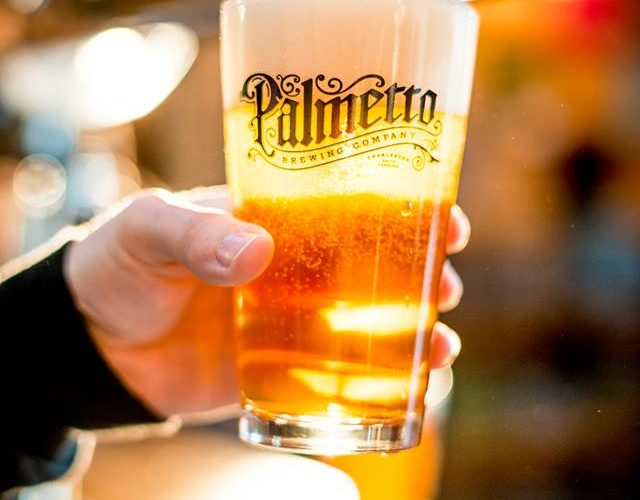On September 18, 2015, the entire Charleston, S.C., brewing community will raise a glass in celebration of the 21st anniversary of Palmetto Brewing Co.’s first beer: Amber Ale. As longtime “distribution wrangler” Clayton Burrous says of the occasion, “The fact that [founder Ed Falkenstein] made a beer in 1994 that’s still relevant in today’s market is definitely something to celebrate.”
Founder Falkenstein recalls going to the Pacific Northwest in the 1980s for his previous job in chemical engineering and seeing the previously depressed Mount Hood region grow and thrive once local breweries opened. He thought that would be something that would work in Charleston, which hadn’t had a production brewery since the original Palmetto Brewery in the 19th century, which closed before Prohibition.
At that time there were no breweries in South Carolina at all, which meant that the entire infrastructure to license a brewery had been long lost by the state, who instructed Falkenstein to “create your own form and send it to us. Just include any info you think we need to know.”
Palmetto opened in 1994 with their Amber Ale, American amber ale; followed by Pale Ale, American pale ale; Lager, American lager and Espresso Porter, coffee porter. All four are still being brewed today and make up the core brands of the brewery.
John Planty has been CEO of Palmetto since 2012 and has overseen the growth of the brewery in the wake of the state laws passed in 2013 and 2014 that have eased restrictions on breweries selling their beer on site. The brewery was able to open a full-scale tap room both to generate income and provide more creative beers to the public.
“We weren’t really playing that game before, there was just the need for the core brands,” Planty says.
834 Series
Planty has also helped drive a diversification in Palmetto’s beer portfolio, guiding the creation of its 843 Series, which has added a seasonal element to the brewery’s offerings. Sales in the tap room of the beers in this series benefit local Charleston non-profit organizations.
“For the first month of sales in our tap room, we donate $1 from every pint sold of the 843 Series,” says Planty. “My vision was, that as a community, we would all rally behind that. We can provide a lot bigger contribution to our community. And it became a vehicle for creating diversity in our portfolio.”
According to head brewer Clint VIck, the team tries to pay homage to the history of Charleston with its seasonal and specialty brews. “We currently offer Aftershock, a steam lager, named for the earthquake followed by the hurricane that wiped out the first brewery of the state in the 1800s. The beer was commissioned to go with the book that’s being published about that storm.”
The 843 series—named for Charleston’s telephone area code—has been wildly successful. The Hugar Street Wheat IPA and Ghost Rider pale ale spiced with cherries and smoked ghost peppers sell out immediately upon release. “We can’t make enough,” Planty says.
With Age Comes Responsibility
Planty says that in 2012, Palmetto brewed and distributed between 2,500 and 3,000 barrels, and this year they’re on track to get 10,000 barrels out into their market, the majority of which will be sold between Charleston and Hilton Head.
Although that distribution area is growing, according to Burrous, who manages Palmetto’s rapidly growing distributor relationships around the state. He also works to open new markets and helps to manage the flow of production accordingly.
“People are gobbling up local crafts,” Burrous notes. “There’s a lot of great beer and a lot of great breweries out there. We do have an advantage being the oldest brewery, but that also comes with some challenges, to those who are edgy, cool, and new. We want to create awareness around new brands—that’ll get back to the core brands as well. We want to be relevant to the current popular styles—we can’t rest on our laurels.”
He adds, “Charleston is certainly getting more crowded—there are another 11 breweries locally and several more that have applied. Is everyone focused on quality and consistence? Are people putting the best product out there? The second the beer becomes questionable it affects the entire local industry.”
Planty agrees. “As a 21 year old brewery, you have an obligation to help out the new guys, to ensure quality and consistency throughout the region.”
 Nora McGunnigle is a freelance beer and food writer living in New Orleans, focusing and the unique food and beer culture of Louisiana and the Gulf region. Her work can be found in Beer Advocate, All About Beer and Louisiana Kitchen and Culture and is a regular contributor to Southern Brew News, Alcohol Professor, Eater NOLA, and the New Orleans alt-weekly, The Gambit. Follow her on Twitter at @noradeirdre and keep up with her work at NOLAbeerblog.com.
Nora McGunnigle is a freelance beer and food writer living in New Orleans, focusing and the unique food and beer culture of Louisiana and the Gulf region. Her work can be found in Beer Advocate, All About Beer and Louisiana Kitchen and Culture and is a regular contributor to Southern Brew News, Alcohol Professor, Eater NOLA, and the New Orleans alt-weekly, The Gambit. Follow her on Twitter at @noradeirdre and keep up with her work at NOLAbeerblog.com.
CraftBeer.com is fully dedicated to small and independent U.S. breweries. We are published by the Brewers Association, the not-for-profit trade group dedicated to promoting and protecting America’s small and independent craft brewers. Stories and opinions shared on CraftBeer.com do not imply endorsement by or positions taken by the Brewers Association or its members.

Share Post